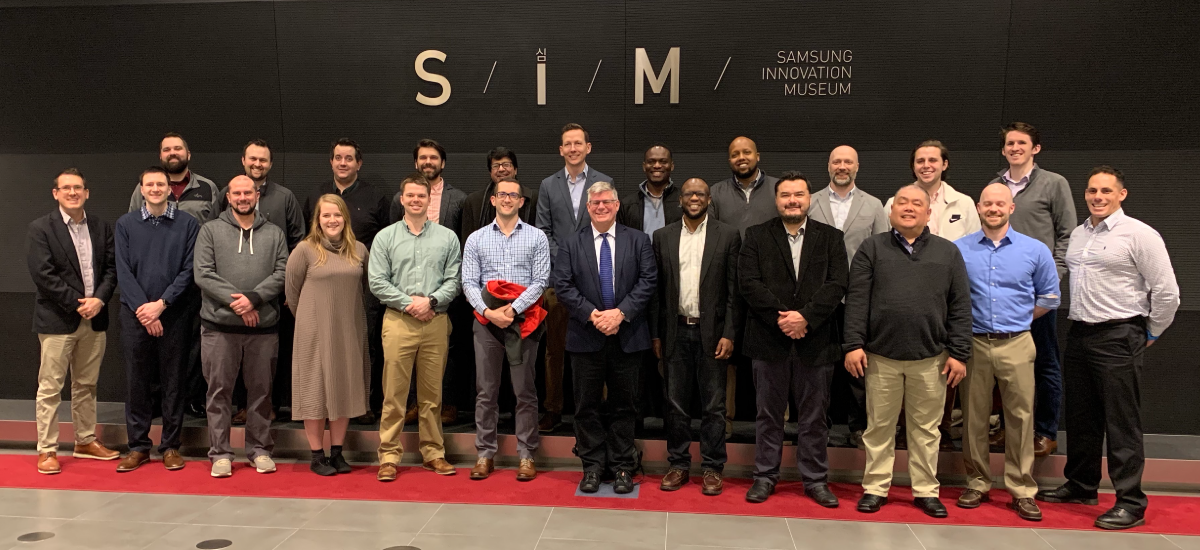MOT 2020 Students, Faculty Recount Their Experience Abroad in Korea, Vietnam

As the Director of Graduate Studies for the M.S. in Management of Technology (MOT) program, I have the privilege of accompanying our senior cohort on their international trip every year. During this trip, formally the International Management of Technology (IMTP) project, we typically visit two cities in different countries over an approximately two-week period. This year — we returned two weeks ago — our destinations were Seoul, South Korea and Ho Chi Minh City, Vietnam.
The trip is a “once in a lifetime experience” in the words of some students. Even for the faculty leaders — like our associate director Paul Hansen, who also accompanied the students — it is always enlightening and exciting.
Our days during IMTP are spent in intensive presentations and discussions, typically with senior executives in international and domestic technology-oriented companies. This time around, our visits included the following:
- General Motors Korea, where the CEO and President of GM Korea and the President of the GM Technical Center Korea spent a couple of hours with us giving their perspectives on industry trends and GM’s operations in Asia. We also toured GM’s crash-testing facility;
- Samsung Electronics, where we also visited the Samsung Innovation Museum, which featured displays of earliest-to-latest electronics devices, appliances and other technology;
- You Me, the leading intellectual property company in Korea, where we were hosted by Jack Yongkyoo Lee, an MOT ’17 alumnus who is an expert on the startup ecosystem in South Korea;
- Microsoft Vietnam, where cloud platforms were a particular topic of discussion. Microsoft Azure is contributing to significant growth for Microsoft in the country;
- TMA Solutions and FPT Software, the two largest software services companies in Vietnam;
- Intel Vietnam, which is Intel’s largest assembly test manufacturing (ATM) site and is responsible for the majority of Intel’s ATM.
That’s just a sampling of our numerous visits; we also had sessions in our hotel with several industry and academic leaders in both locations.
But what did we learn, you might well ask? Here are some of my takeaways from each place:
Korea: Chaebols—large, family-run industrial conglomerates (Samsung, LG, Hyundai and others) play an outsize role in South Korea’s economy. Altogether, the chaebols account for the majority of South Korea’s GDP. Samsung Group itself accounts for over 10 percent.
The progress that South Korea has made is striking. It has gone from being one of the poorest countries in the world after the Korean War to what is now the 12th-largest economy in the world. The country continues to be a leader in technology innovation. To note one example, three of the top five battery manufacturers are Korean: LG Chemicals, Samsung STI and SK Innovation.
But all is not rosy: A particular challenge that Korea faces is its aging population. By some accounts, the country has the lowest birthrate in the world.
Vietnam: In choosing our destinations for the IMTP trip we hope to illustrate contrasts. Going to Vietnam after South Korea served this purpose well. From stable, prosperous Seoul we went to chaotic, vibrant Ho Chi Minh City. In fact, Ho Chi Minh City is number eight on the World Economic Forum’s list of the world’s “most dynamic cities.”
Vietnam is still a poor country, but it has been on an economic tear (6+ percent GDP growth rate since 2014). The majority of Vietnamese still work in agriculture, so the workforce to spur further industrialization exists. Demographics favor the nation in other respects too; the average age of the population is only 30 or so (one company we visited talked about the annual “Parents’ Day” they hold!).
Although high-tech manufacturing is prominent and growing rapidly in Vietnam (the country is also benefiting from U.S.-China trade tensions, but that’s “icing on the cake” as we were told), we heard a concern being voiced: unlike South Korea, Vietnam does not have major homegrown technology/manufacturing companies. Instead, it’s the facilities of companies like Intel and Samsung that are responsible for the growth of high-tech exports (and much of the growth of the economy as a whole). As labor costs rise, Vietnam could become less competitive as an offshoring manufacturing destination.
Student Perspectives:
Three of our students shared some of their experiences as well, and we invite you to review them:
- Deatrick LaPointe discusses his “once in a lifetime” experience.
- Mariah Marx notes some “everyday innovations” she encountered.
- In a more practical vein, Walker Glesoe offers advice for travelers (and future MOT cohorts, we expect).
If you would like to learn more about how IMTP and how an M.S. in Management of Technology from the Technological Leadership Institute can benefit your career, attend an upcoming information session or contact our admission department.
About the Author

Tariq Samad, PhD
- Honeywell/W.R. Sweatt Chair in Technology Management
- Senior Fellow
- Director of Graduate Studies
- MOT and MDI Faculty
Honeywell/W.R. Sweatt Chair in Technology Management
Dr. Tariq Samad brings more than 30 years of professional experience, leadership and expertise to TLI. His corporate career was spent at Honeywell, where he focused on technology strategy and management, encompassing the end-to-end concept-to-commercialization pathway. He also has substantial experience in research and innovation globally, and works with TLI to pursue research interests in areas such as clean energy, advanced manufacturing and smart cities. Dr. Samad serves as the director of graduate studies for the Master of Science in Management of Technology degree program at TLI.